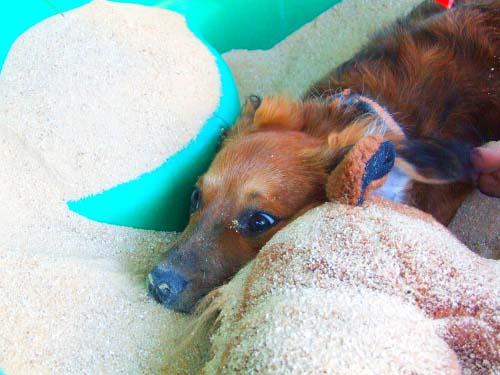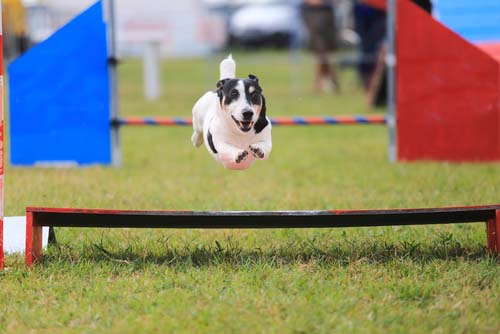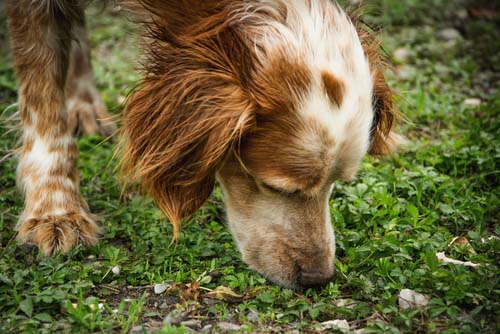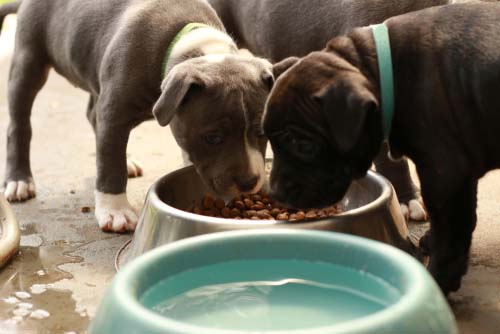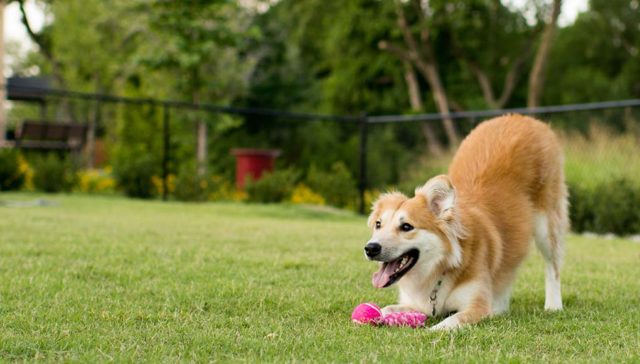
A dream backyard for the dog isn’t about you concocting weird and crazy expensive playgrounds; it’s about working towards addressing the needs and wants of a dog, as well as keeping your pet safe and entertained.
All of this can be done pretty cheaply.
Take the time to provide the dog with at least the most essential backyard amenities, such as shade in summer, to keep the dog safe, happy, and content.
Below are some ideas to keep your pooch always wanting to go back to the backyard while you are at work.
Dog-Friendly Backyard Ideas
1. Fencing
Even though dogs love running around and sniffing this and that, they, like children, need fences to keep them safe and on your premises.
Whether standard fences or invisible ones, this is essential for the protection of the dog.
Along with fencing, you can add plants and creepers to make it feel free and natural for the dog.
Consider fencing material that matches your landscape style for your dog in the backyard, whether it will be an enclosed yard or a dog run.
If you already have a fence but your dog keeps jumping over it, put up some prevention.
It doesn’t matter which style you choose as long as it’s sturdy enough so your dog can’t get out and safe enough so the dog's head doesn't get stuck between the boards.
If you have a wooden fence or similar that obstructs viewing, very curious dogs, will love a viewing bubble or a dog fence window in there to observe the world behind it.
2. Doggy Window
You can't have fencing without a doggy window.
This way, your pup can see what's beyond just their play area.
It's also a benefit so your dog doesn't get spooked by loud sounds.
I will say this with a caveat. If you're going to do this, I recommend you train your dog not to bark.
Some people think that dogs won't bark if they can see what is making sounds beyond their fence, but in my personal experience, it's mixed.
And I lean more to the side if your dog can see whatever is causing noise and people; they tend to bark as a way to “scare off” the possible trespasser.
3. Marking Spots
Dogs like to mark their territory when they’re out in the yard; they like to choose their own places to do their business and will often keep going in the same spot.
If you don't want the dog to pick a random spot, you can set up specific spots yourself to encourage the dog to pee and poo there.
For fun, you can get a fake fire hydrant, but large stones in the garden or some sculptured driftwood pieces are good choices, too.
4. Digging Area
Most homeowners don’t even like to hear this word when it comes to their garden or backyard.
But the truth is, dogs love digging.
So, instead of shouting at your dog, make some special space in the backyard for them to dig and bury some bones or toys.
You can get a sandbox, a big one like this, or a smaller one like this.
Install it to keep your dog out of your flower beds.
Place the sandbox in an unused corner of your yard and fill it with sand or mulch that’s easy to dig up and refill.
It’s a great way to satisfy your dog’s urge to dig and save the rest of the yard.
Alternatively, you can plant artificial grass, which can discourage the dog from digging altogether, and this grass doesn’t turn yellow and dies off in the places where the dog relieves himself.
5. Covered Spot
A backyard where your dog spends many hours during the day and that does not provide shade is dangerous, especially in summer.
Dogs can suffer from severe dehydration, heat stroke, and sunburn, particularly if you live in warmer weather areas.
For safety, you can plant some trees that provide shade.
However, an easier solution would be some type of gazebo, an overhead tarp, or just a dog house that is made from wood (and ideally, elevated) to keep the dog cool.
If you're getting a shade or gazebo, or something similar, consider also a dog pool placing under that shade.
This would be a heavenly spot for your dog during the hot summer months.
6. Good Paths
Dogs enjoy walking and wandering around pathways in the backyard.
If you're renovating your backyard, consider using materials that will feel good for the dog's paws: cool and therapeutic, smooth round cobbles, bricks, and green lawns.
Some ideas to think about:
- Clover: Clover is safe for dogs to eat, and it’s tougher than grass.
- Synthetic turf: Turf is low-maintenance and also reduces the need to mow, and also stops the dog from digging.
- More durable grass: No grass is totally immune to stains, but you could invest in tougher type grasses such as Buffalo Grass or Kentucky Bluegrass – they withstand urine better.
- Mulch: This is a safe, inexpensive option. Cedar mulch also acts as a natural bug repellent to fight off ticks and fleas. Stay away from cocoa bean mulch, though; it’s dangerous for dogs if ingested.
7. Agility Training Kit or DIY Course
Even if you're not into agility training and competing with your dog professionally, there are many benefits of agility training for dogs, both physical and mental.
While it's a great activity for dogs when you can run around with them, you don't always have to.
Simply get a cheap agility kit and set up some things in the backyard for your pooch to enjoy on their own and entertain themselves.
You can also create your own DIY agility course as well. Just gotta use your imagination.
8. Drinking Spot
Absolutely essential is access to water for your dog to drink, especially in summer and if your pup spends a lot of time outdoors.
You can simply keep putting out fresh cold water in a bowl, but to make it easier, invest in a pet water fountain or a stream.
You could put in a pet-friendly pond, too, for the water-loving dog, with a gently sloping side or accessible steps to make sure the dog can climb out easily if he falls in.
9. No Toxic Stuff
Keep your landscaping free of toxins.
Some plants are pretty dangerous if your dog eats them and can cause anything from digestive disorders to even death.
Also, many baits for snails, pests, and rats can be fatal to your dog, so if you have to use baits and poisons in the backyard, ensure that your dog can’t reach them.
If you want to grow some safe plants for dogs, there are also plenty of options, some of which can even be beneficial to dogs:
- Peppermint: Modern Dog magazine says peppermint helps with stomach aches gas relief and reduces nausea
- Valerian, Chamomile, and California poppy: All of these herbs are natural relaxants for dogs – a happy, healthy, relaxed dog won’t be a constantly barking dog. They help to lower blood pressure and even assist in the fight against parasites.
- Basil: The plant is an anti-oxidant, anti-microbial, and anti-viral.
- Milk Thistle: This herb is anti-inflammatory and anti-oxidant and excellent for protecting and even improving your dog’s liver health. If your pet has environmental allergies, though, milk thistle should be used with caution.
10. Dining Area
Don’t feed your dog from the table.
Give your pet its own special place outdoors where the dog can enjoy their healthy snacks and meals.
Perhaps you could build your pup a simple platform that keeps the dog's clean dishes in when they are not being used to keep the backyard looking neat, tidy, and together.
11. A Place to Play
A tired dog is a good dog, so make sure there is plenty of place in the backyard for the dog to run around and play with toys.
A dog needs to be entertained and not bored when you are not at home, so having some space is crucial.
You can dress up the “play spot” too.
Some extra special and cheap items like agility rings and tunnels mentioned above, balance beams, and pipes as fun obstacle courses for your dog are great.
Your pet will burn off all that excess energy if you don’t have heaps of backyard space for them to run.
FAQ
How do dogs damage lawns?
As nice as it sounds to just let your dog run around in your backyard free like the wind, it's got risks.
Your dog will do whatever it can to entertain itself, including damaging your lawn by doing things like:
- Peeing/Pooping: Relieving themselves
- Digging – once dogs figure out how to dig, it's tough to keep them from doing it
- Chewing on the fence
- Running around – depending on the size, the heavier the dog is, the easier it is for the dog to damage your lawn by just simply running. Their running back and forth can tear up the lawn and can kill the grass they frequently run on.
What kind of yard is best for dogs?
If you can afford it, we recommend a grassless lawn. An astroturf lawn is perfect.
Or you can opt for just tougher grass.
If you live in cooler climates, the tougher grass blends include:
- Tall Fescue
- Kentucky Bluegrass
- Perennial ryegrass
If you live in hotter climates, opt for:
- Bermuda grass
- Zoysiagrass
Are dogs happier with a backyard?
No. Though it may seem that a dog with more room to roam is happier, this isn't always the case.
A dog that lives in an apartment can be much happier than a dog with a backyard, depending on how their other needs are met.
Dog-Friendly Backyard Ideas: Final Thoughts
Now you have some great ideas to implement.
Go with the ones that best fit your lifestyle and budget.
If you liked this article, be sure to check out the article below!
READ NEXT: How to Create A Backyard Paradise For Your Dog
Disclosure: We may earn affiliate commissions at no cost to you from the links on this page. This did not affect our assessment of products. Read more here and find full disclosure here.




